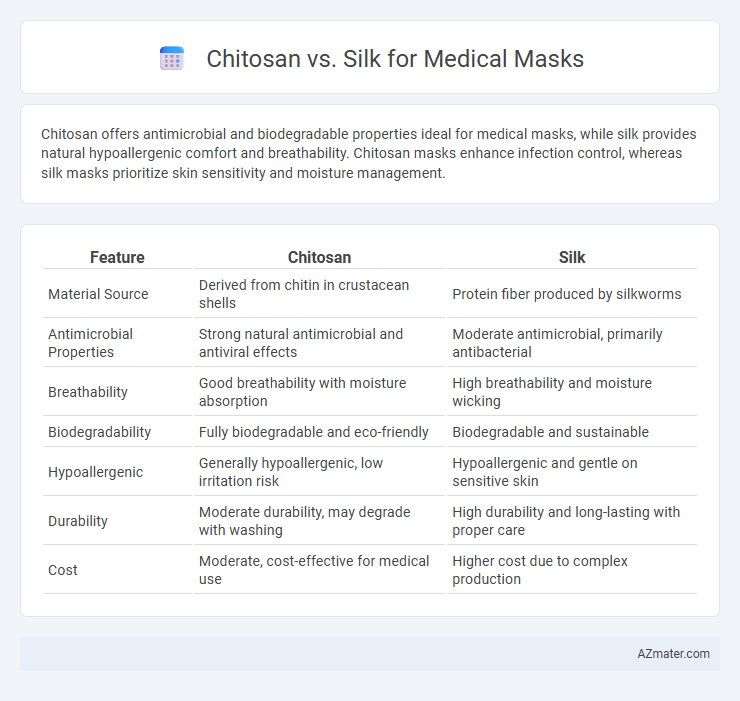Chitosan offers antimicrobial and biodegradable properties ideal for medical masks, while silk provides natural hypoallergenic comfort and breathability. Chitosan masks enhance infection control, whereas silk masks prioritize skin sensitivity and moisture management.
Table of Comparison
| Feature | Chitosan | Silk |
|---|---|---|
| Material Source | Derived from chitin in crustacean shells | Protein fiber produced by silkworms |
| Antimicrobial Properties | Strong natural antimicrobial and antiviral effects | Moderate antimicrobial, primarily antibacterial |
| Breathability | Good breathability with moisture absorption | High breathability and moisture wicking |
| Biodegradability | Fully biodegradable and eco-friendly | Biodegradable and sustainable |
| Hypoallergenic | Generally hypoallergenic, low irritation risk | Hypoallergenic and gentle on sensitive skin |
| Durability | Moderate durability, may degrade with washing | High durability and long-lasting with proper care |
| Cost | Moderate, cost-effective for medical use | Higher cost due to complex production |
Introduction to Biopolymer-Based Medical Masks
Biopolymer-based medical masks leverage natural polymers like chitosan and silk to enhance filtration, biocompatibility, and antimicrobial properties. Chitosan, derived from chitin in crustacean shells, offers strong antibacterial effects and biodegradability, making it ideal for reducing pathogen transmission in masks. Silk, celebrated for its excellent breathability, mechanical strength, and natural protein structure, provides comfort and durability while maintaining effective filtration in medical masks.
Chitosan: Properties and Biomedical Applications
Chitosan, a biopolymer derived from chitin, exhibits exceptional biocompatibility, biodegradability, and antimicrobial properties, making it a superior material for medical mask applications compared to silk. Its inherent ability to promote wound healing, reduce inflammation, and provide effective barrier protection enhances respiratory safety in clinical settings. Chitosan-based masks demonstrate significant potential in advanced biomedical applications, including drug delivery systems and tissue engineering, due to their customizable molecular structure and bioactivity.
Silk: Unique Qualities in Medical Textiles
Silk exhibits remarkable biocompatibility and natural antimicrobial properties, making it an ideal material for medical masks that require both comfort and protection. Its smooth, hypoallergenic fibers reduce skin irritation while maintaining breathability, enhancing patient compliance during extended use. The ability of silk to retain moisture without compromising filtration efficacy distinguishes it as a superior textile in medical applications compared to chitosan-based materials.
Filtration Efficiency: Chitosan vs Silk
Chitosan-based medical masks exhibit superior filtration efficiency due to their antimicrobial properties and ability to form a dense, electrostatically charged layer that captures particles effectively, outperforming traditional silk masks. Silk masks offer moderate filtration by leveraging their natural fiber density and electrostatic effects but lack the active antimicrobial filtration enhancement found in chitosan. Studies indicate chitosan-coated filters achieve up to 95% filtration efficiency against airborne particles smaller than 0.3 microns, while silk masks typically provide filtration efficiencies around 70-80%.
Breathability and Comfort Comparison
Chitosan masks exhibit enhanced breathability due to their porous structure, which facilitates better air circulation and reduces heat buildup compared to silk masks. Silk, while naturally smooth and hypoallergenic, tends to retain more moisture, potentially decreasing comfort during extended wear. Studies indicate that chitosan's antimicrobial properties combined with superior moisture-wicking contribute to overall increased comfort in medical mask applications.
Antimicrobial Properties: Evaluating Effectiveness
Chitosan exhibits strong antimicrobial properties by disrupting bacterial cell membranes and promoting wound healing, making it highly effective for medical mask applications. Silk offers natural antimicrobial effects through its sericin protein, which can inhibit microbial growth while providing biocompatibility and comfort. Studies indicate chitosan-infused masks achieve superior bacterial filtration and sustained antimicrobial activity compared to conventional silk masks, enhancing overall protection in clinical settings.
Biodegradability and Environmental Impact
Chitosan-based medical masks outperform silk masks in biodegradability due to their natural polysaccharide composition derived from crustacean shells, allowing rapid decomposition without toxic residue. Silk masks, although biodegradable, degrade slower and may require specific industrial composting conditions, contributing to prolonged environmental persistence. The environmental impact of chitosan masks is significantly lower as they reduce plastic waste and promote circular bioeconomy practices, making them a sustainable alternative in medical mask production.
Skin Compatibility and Allergenic Potential
Chitosan exhibits excellent skin compatibility due to its natural bioactive properties that promote hydration and reduce irritation, making it suitable for sensitive skin in medical masks. Silk, known for its smooth texture and hypoallergenic characteristics, minimizes friction and allergic reactions, enhancing comfort for prolonged use. Both materials demonstrate low allergenic potential, but chitosan's antimicrobial effects provide added protection against skin infections compared to silk.
Cost and Scalability for Mass Production
Chitosan-based medical masks offer competitive antimicrobial properties but face challenges in cost-efficiency and scalability compared to silk, which benefits from established large-scale production infrastructure and lower raw material expenses. Silk masks provide a balance of comfort and breathability with more predictable manufacturing costs, making them more viable for mass production. While chitosan's biocompatibility and biodegradability are advantageous, high extraction and processing costs limit its economical scalability in the medical mask industry.
Future Prospects: Innovation in Mask Materials
Chitosan, derived from crustacean shells, offers antimicrobial properties and biodegradability, making it a promising material for future medical masks that prioritize both safety and environmental sustainability. Silk, known for its natural hypoallergenic and breathable qualities, is being innovatively engineered with nanotechnology to enhance filtration efficiency and moisture control in next-generation masks. Combining biopolymer innovation with advanced textile engineering, medical masks are poised to improve protection while reducing ecological impact.

Infographic: Chitosan vs Silk for Medical Mask
 azmater.com
azmater.com